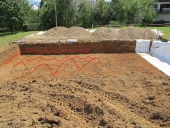posted 8 years ago
Probably fine to use in cob, but let me share a cautionary tale:
I led a volunteer project to build an earthbag and cob bench in a public garden in our little town. After the cob cured we put on a lime plaster with a wood ash pozzolan. I wanted some sort of fibre in the plaster to help prevent cracking and since we have alpacas, I had the bright idea of bringing a bag of shearing seconds (the low-quality bits like the legs and belly that aren't worth spinning). The idea was to mix the alpaca fleece into the plaster as thoroughly as possible, then trowel it on.
All went according to plan, and the plaster mixed like butter. It was a joy to work with, went on smooth, and hardened in a matter of days thanks to the added ash. I wanted it to weather for a few months before finishing it off with a silicate paint, which would waterproof it but remain breathable.
So then we got a month's worth of rain in about a week. I went to check on the bench and the beautiful plaster finish had erupted in hundreds of zits, most about the size of my thumbnail. A few had popped off the topmost layer of hard plaster, and that exposed the problem: little clumps of fleece, which had absorbed water and expanded, with nowhere to go but outward. So that involved a major corrective action.
All that said, yarn scraps in cob should be ok as long as it's got a good exterior surface, plus good hat and boots.










